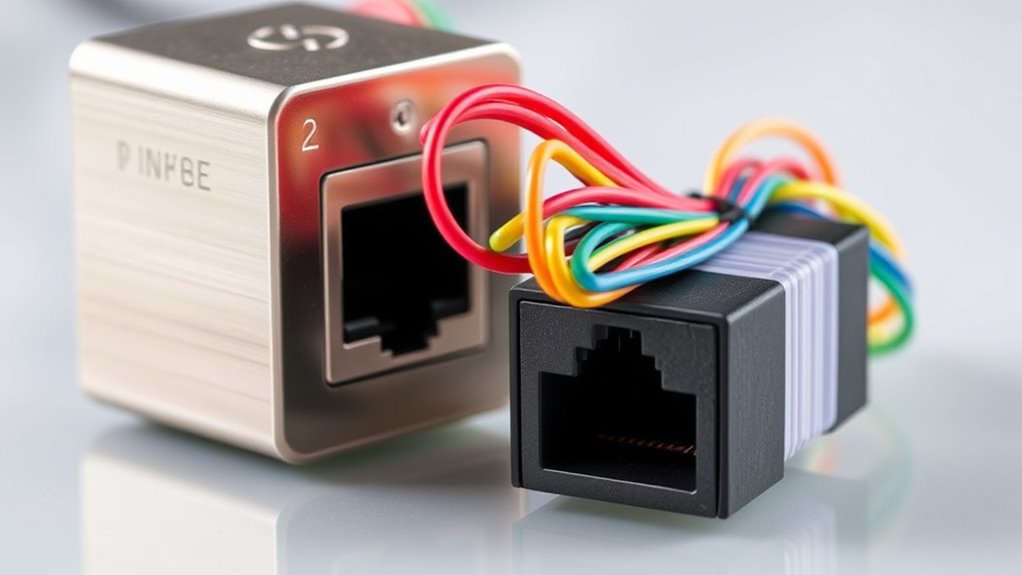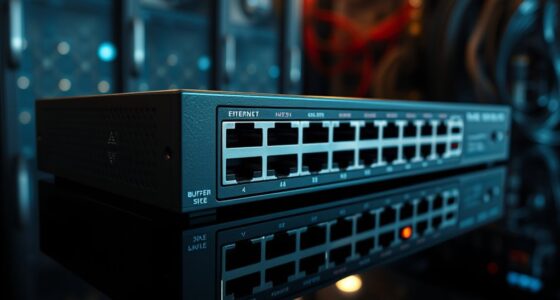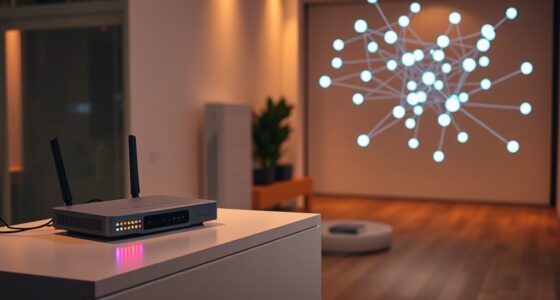Passive PoE injectors and splitters send fixed voltage levels without negotiation, which can be risky if your devices aren’t designed for that voltage. Active PoE devices, however, negotiate power levels to guarantee compatibility and safety, making them a smarter choice for varied or sensitive equipment. While passive options are cheaper and simpler, active solutions offer safer, standards-compliant delivery. To find out which solution suits your setup best, explore the key differences and benefits below.
Key Takeaways
- Passive PoE injectors and splitters send fixed voltage regardless of device compatibility, risking damage if voltage is incompatible.
- Active PoE devices negotiate power levels, ensuring safe and appropriate power delivery per standards like IEEE 802.3af/at/bt.
- Passive solutions are simpler and cheaper but less flexible, suitable for controlled environments with known device requirements.
- Active PoE offers better safety, compatibility, and supports a wider range of network devices through negotiation.
- Choosing between passive and active depends on environment, device compatibility, safety needs, and budget considerations.

Are you trying to decide between passive and active PoE injectors and splitters for your network setup? Understanding the key differences can help you choose the right solution for your needs. Power over Ethernet, or PoE, allows you to transmit power and data through a single Ethernet cable, simplifying installations and reducing clutter. When selecting between passive and active PoE devices, you need to take into account how they deliver power and how compatible they are with your network devices.
Passive PoE injectors and splitters send power without negotiating with the connected device. They provide a fixed voltage, typically 12V or 24V, regardless of whether the device can handle that power. This can be simpler and cheaper, but it also comes with risks. If your network device isn’t designed to accept that specific voltage, it could be damaged or simply not work properly. Compatibility becomes a major concern here; you need to verify that your device supports the power level offered by the passive injector or splitter. If your device is compatible, passive solutions can be effective for straightforward installations, especially in controlled environments where the power requirements are well known. Additionally, understanding power delivery standards helps ensure your setup remains safe and reliable.
Passive PoE sends fixed voltage power without negotiation, risking damage if devices aren’t compatible.
Active PoE injectors and splitters, on the other hand, negotiate power with connected devices. They follow standards such as IEEE 802.3af, 802.3at, or 802.3bt, which define how power is supplied and managed. This negotiation ensures that the device receives the appropriate amount of power and reduces the risk of damage. Active devices are more versatile because they automatically detect whether a connected device supports PoE and adjust their power output accordingly. This compatibility feature makes active PoE solutions suitable for a wider range of network devices, from IP cameras and VoIP phones to wireless access points, all of which may have different power requirements.
Choosing between passive and active PoE injectors and splitters largely depends on your network device compatibility and the level of safety you need. If your devices are designed to handle a fixed voltage and you want a cost-effective solution, passive options might work. However, if you need a flexible, safer, and standards-compliant setup that can adapt to different devices, active PoE solutions are generally the better choice. Remember, ensuring compatibility and understanding how power is delivered can save you from costly mistakes and future troubleshooting.
Frequently Asked Questions
Can Passive Poe Injectors Support High-Power Network Setups?
Passive PoE injectors generally can’t support high-power network setups because they don’t comply with Power Over Ethernet standards that guarantee safe, reliable power delivery. If you want to scale your network effectively, you need active injectors designed for higher power levels, which improve network scalability and device compatibility. Active injectors manage power more efficiently, making them ideal for demanding setups requiring higher wattages and better performance.
Are Active Poe Injectors More Reliable Than Passive Ones?
Active PoE injectors are generally more reliable than passive ones, with over 90% of network professionals preferring them for critical setups. They provide better power stability, ensuring consistent device performance. While active injectors are compatible with most devices, some compatibility concerns can arise with older equipment. Overall, if you need dependable power delivery and fewer issues, active PoE injectors are the smarter choice for your network.
What Are the Cost Differences Between Passive and Active Injectors?
Passive Poe injectors are generally cheaper upfront, with lower installation costs, since they don’t require power sources or complex components. Active injectors tend to be more expensive due to their built-in power management and enhanced features, but they offer better power efficiency and reliability. If you need a cost-effective solution and have straightforward requirements, passive injectors are suitable. For higher performance and stability, investing in active injectors might be worth the extra cost.
Do Splitters Impact Network Speed or Latency?
Think of network splitters as forks in a river, dividing water flow but not necessarily slowing it down. Splitters don’t impact your network speed or latency considerably, but they can cause slight signal degradation over long distances. While they’re power-efficient, using splitters might make your signal weaker, so it’s essential to take into account the distance and quality of your cabling to maintain peak performance.
How Do Environmental Factors Affect Splitter Performance?
Environmental factors like power fluctuation and temperature sensitivity can profoundly impact splitter performance. Power fluctuations may cause inconsistent operation or damage, so guarantee stable power sources. Temperature extremes can lead to overheating or condensation, affecting signal quality and reliability. Keep splitters in controlled environments, away from heat sources or moisture, and use surge protectors to minimize disruptions. Proper environmental management helps maintain consistent network performance and prolongs device lifespan.
Conclusion
Think of passive and active PoE injectors and splitters as different routes in a garden maze. Passive ones are like narrow, winding paths—simple but limited. Active injectors and splitters are like main roads—powerful and reliable, guiding your network smoothly. Choosing the right one depends on your needs. With the right gear, your network becomes a well-tended garden, flourishing with seamless connections and steady power, no matter which path you take.








